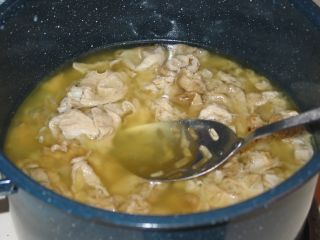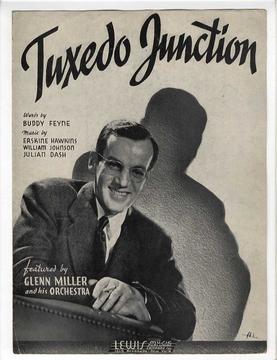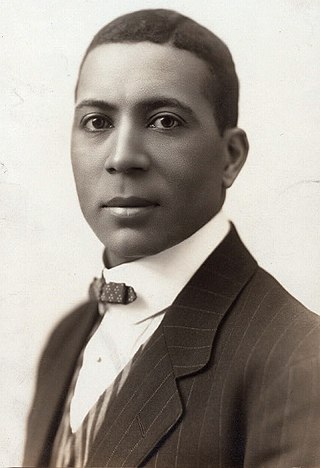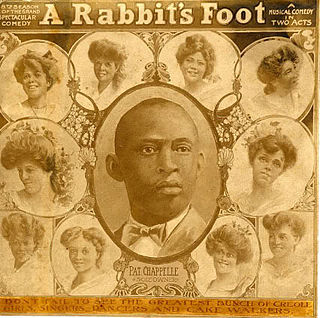
Chitterlings, sometimes spelled chitlins or chittlins, are the large intestines of domestic animals. They are usually made from pigs' intestines. They may also be filled with a forcemeat to make sausage. Intestine from other animals, such as cow, lamb, goose, and goat is also used for making chitterling.
Theatre Owners Booking Association, or T.O.B.A., was the vaudeville circuit for African American performers in the 1920s. The theaters mostly had white owners, though about a third of them had Black owners, including the recently restored Morton Theater in Athens, Georgia, originally operated by "Pinky" Monroe Morton, and Douglass Theatre in Macon, Georgia owned and operated by Charles Henry Douglass. Theater owners booked jazz and blues musicians and singers, comedians, and other performers, including the classically trained, such as operatic soprano Sissieretta Jones, known as "The Black Patti", for black audiences.

Don Deadric Robey was an American record label executive, songwriter, and record producer. As the founder of Peacock Records and the eventual owner of Duke Records, he was responsible for developing the careers of many rhythm and blues artists in the 1950s and 1960s. He was the first African American record mogul, 10 years prior to Berry Gordy's Motown label.

"Good Rocking Tonight" is a jump blues song originally released in 1947 by its writer, Roy Brown and was covered by many recording artists. The song includes the memorable refrain, "Well I heard the news, there's good rocking tonight!" The song anticipated elements of rock and roll music.

Victory Grill is a historic music venue located at 1104 E. 11th St, Austin, Texas. The nightclub was on the Chitlin' Circuit and hosted famous African American acts such as Bobby Bland, Clarence "Gatemouth" Brown, W. C. Clark and B. B. King when Austin was legally segregated. Victory Grill was added to the National Register of Historic Places on October 16, 1998.

"Tuxedo Junction" is a popular big band song recorded by Glenn Miller and His Orchestra, becoming a No. 1 hit in 1940. The music was written by Erskine Hawkins, Bill Johnson, and Julian Dash and the lyrics by Buddy Feyne. The song was introduced by Erskine Hawkins and His Orchestra, a college dance band previously known as the Bama State Collegians. RCA released it in 1939 and it climbed to #7 on the American pop charts.

Sherman Houston Dudley was an African-American vaudeville performer and theatre entrepreneur. He gained notability in the late nineteenth and early twentieth century as an individual performer, a composer of ragtime songs, and as a member and later owner of various minstrel shows including the Smart Set Company. Dudley is also notable as one of the first African Americans to combine business with theater, by starting a black theater circuit, in which theaters were owned or operated by African Americans and provided entertainment by and for African Americans. He created the first black operated vaudeville circuit and led the way for what became the Theatre Owners Booking Association (T.O.B.A.).

The Rabbit's Foot Company, also known as the Rabbit('s) Foot Minstrels and colloquially as "The Foots", was a long-running minstrel and variety troupe that toured as a tent show in the American South between 1900 and the late 1950s. It was established by Pat Chappelle, an African-American entrepreneur in Tampa, Florida.
Walter Barnes was an American jazz clarinetist, saxophonist, and bandleader.

The Uptown Theater in Philadelphia, Pennsylvania, also known as Uptown Theater and Office Building, is an Art Deco building built in 1927. It was designed by the Philadelphia-based architectural firm of Magaziner, Eberhard & Harris. The Uptown Theater is located on 2240 N. Broad Street. It became a major venue on the Chitlin' Circuit, from 1951–1978. It was listed on the National Register of Historic Places in 1982.

The Regal Theater was a night club, theater, and music venue, popular among African Americans, located in the Bronzeville neighborhood in Chicago, Illinois. The theater was designed by Edward Eichenbaum, and opened in February 1928. It closed in 1968 and was demolished in 1973.

Black Vaudeville is a term that specifically describes Vaudeville-era African American entertainers and the milieus of dance, music, and theatrical performances they created. Spanning the years between the 1880s and early 1930s, these acts not only brought elements and influences unique to American black culture directly to African Americans but ultimately spread them beyond to both white American society and Europe.

The B. F. Keith Circuit was a chain of vaudeville theaters in the United States and Canada owned by Benjamin Franklin Keith for the acts that he booked. Known for a time as the United Booking Office, and under various other names, the circuit was managed by Edward Franklin Albee, who gained control of it in 1918, following the death of Keith's son A. Paul Keith.

Sax Kari, born Isaac Columbus Toombs Jr., sometimes known as Isaac Saxton Kari Toombs or simply Saxton Kari, was an American multi-instrumentalist, bandleader, songwriter, record producer, A&R man and promoter, who had a wide variety of roles during a career in African American entertainment and R&B music lasting from the 1920s to the 1990s. He also used pseudonyms, including Ira Green, Texas Red, Dirty Red Morgan, and Candy Yams.
William Fuse Benbow was an American vaudeville entertainer who was the manager of the Alabama Chocolate Drops touring company and "a pioneer of black vaudeville entertainment in the southern states in the early part of the twentieth century".
Evelyn "The Whip" Young was an American saxophonist from Memphis, Tennessee, United States.

Denver Darious Ferguson Sr. was an American businessman and nightclub owner in Indianapolis, who had a leading role in establishing the "Chitlin' Circuit" of United States entertainment venues for black entertainers and audiences in the 1930s and 1940s. Earlier in his career he established a newspaper, The Edmonson County Star, in his home town of Brownsville, Kentucky, before moving to Indianapolis, where he established a printing company. His younger brother, Sea Ferguson, helped in the print shop and with Denver's other business ventures.
Andrew "Sunbeam" Mitchell was a Memphis-based businessman. He operated the Mitchell Hotel which lodged well-known musicians, and soon he began operating nightclubs on the Chitlin' Circuit such as the Club Handy, Club Ebony, and the Club Paradise. Mitchell ran nightclubs for 40 years until selling off his holdings in the 1980s.
The Hippodrome was a music venue at 500 Beale Street in Memphis. The venue was opened in 1950 as a skating rink for African-Americans and later became a nightclub. In 1955, the Hippodrome was reopened as the Club Ebony. In 1961, under new owners, it went back to being called the Hippodrome until its closure in 1968.











